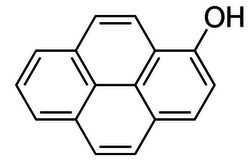1-Hydroxypyrene
 | |
| Names | |
|---|---|
| IUPAC name
Pyren-1-ol | |
| Identifiers | |
| 5315-79-7 | |
| 3D model (Jmol) | Interactive image |
| ChEBI | CHEBI:34093 |
| ChemSpider | 20100 |
| ECHA InfoCard | 100.152.834 |
| KEGG | C14519 |
| PubChem | 21387 |
| |
| |
| Properties | |
| C16H10O | |
| Molar mass | 218.26 g·mol−1 |
| Except where otherwise noted, data are given for materials in their standard state (at 25 °C [77 °F], 100 kPa). | |
| Infobox references | |
1-Hydroxypyrene is a human metabolite. It can be found in urine of outdoor workers exposed to air pollution.[1]
Experiments in pig show that urinary 1-hydroxypyrene is a metabolite of pyrene, when given orally.[2]
Relationship with smoking
Highly significant differences and dose-response relationships with regard to cigarettes smoked per day were found for 2-, 3- and 4-hydroxyphenanthrene and 1-hydroxypyrene, but not for 1-hydroxyphenanthrene.[3]
Pyrene degradation product by microorganisms
Pyrene alone or a mixture of pyrene with three-ringed polycyclic aromatic hydrocarbons can be degraded by a Mycobacterium sp. strain isolated from mangrove sediments, forming amongst other products 1-hydroxypyrene.[4]
References
- ↑ Is urinary 1-hydroxypyrene a valid biomarker for exposure to air pollution in outdoor workers? A meta-analysis. Manuela Ciarrocca, Maria Valeria Rosati, Francesco Tomei, Assuntina Capozzella, Giorgia Andreozzi, Gianfranco Tomei, Alessandro Bacaloni, Teodorico Casale, Jean Claude Andrè, Mario Fioravanti, Maria Fernanda Cuartas and Tiziana Caciari, Journal of Exposure Science and Environmental Epidemiology, 24, 17-26 (January/February 2014), doi:10.1038/jes.2012.111
- ↑ Identification of 1-hydroxypyrene as a major metabolite of pyrene in pig urine. S. D. Keimig, K. W. Kirby, D. P. Morgan, J. E. Keiser, and T. D. Hubert, Xenobiotica, 1983, Vol. 13, No. 7 , Pages 415-420, doi:10.3109/00498258309052279
- ↑ Urinary monohydroxylated phenanthrenes and hydroxypyrene – the effects of smoking habits and changes induced by smoking on monooxygenase-mediated metabolism. Heudorf U and Angerer J, International Archives of Occupational and Environmental Health, April 2001, Volume 74, Issue 3, pages 177-183, doi:10.1007/s004200000215
- ↑ Metabolite production in degradation of pyrene alone or in a mixture with another polycyclic aromatic hydrocarbon by Mycobacterium sp. Zhong Y, Luan T, Zhou H, Lan C and Tam NF, Environ Toxicol Chem., 2006 Nov, 25(11), pages 2853-2859, PMID 17089707
This article is issued from Wikipedia - version of the 4/29/2016. The text is available under the Creative Commons Attribution/Share Alike but additional terms may apply for the media files.